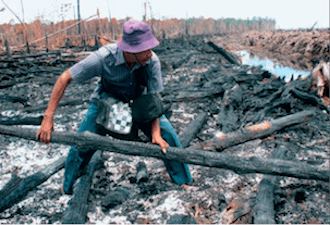The Tripa peat swamp, one of the largest capacities storing carbon in Aceh, is near total ruin. A joint team investigates possible violations that destroyed the once rich peatland forest.
In the middle of a vast, burned-down forest littered with charred, blackened tree trunks, Basuki Wasis instructs one of his staff to stick a pipe into the ground. One enters right through and stops at a meter deep. A second and then a third pipe sinks easily into the swampland. The fourth sinks, and then stops at just 40 centimeters deep.
After taking ground samples, Basuki records his fi ndings in a pocket notebook—this was land with peat layers of 3.6 meters deep. “This is evidence of a violation by planting on peatland,” Basuki told Tempo, who accompanied the researcher from the Bogor Institute of Agriculture (IPB) to the burned swamplands, two weeks ago. A researcher from the IPB’s laboratory for forest ecological systems, Basuki instructed his men to drill holes in six different locations across the peat swamp located within Aloe Bateung Bruek village in Darul Makmur, Nagan Raya regency of Aceh. On this burned land controlled by palm oil plantation company Kallista Alam, they also gathered samples of charred trees and mounds of ash. “This is further proof to take Kallista Alam to court,” said Bayu Hardjanto, an investigator from the Ministry of Environment.
This land used to be the lush Tripa peatland forest, located within the protected Leuser Ecosystem, and referred to as the country’s lungs in the heart of the tsunamiplagued Aceh province. Tripa used to teem with one of the world’s populations of critically-endangered Sumatran orangutans.

Tripa had the largest and the most critical capacity to store carbon in Aceh. A permit to convert the peat swamp was issued to Kallista Alam by the then Aceh Governor, Irwandy Yusuf, on August 25, 2011—three months following the issuance of a map for protected forests, identifying Tripa as a protected zone. The license granted to Kallista involved 1,605 hectares of the peat swamp.
The indicative map of protected forests was drawn up in May 2011 and used in line with a ban on new clearing permits for an area of about 60 million hectares of forests and peatlands, launched under President Yudhoyono’s Reducing Emissions from Deforestation and Forest Degradation Plus (REDD+) program.
The presidential instruction on the ban was issued on May 20 last year. There is also a law in place prohibiting new concessions on land with peat layers more than 3 meters deep.
Nevertheless, Kallista Alam and Surya Panen Subur (SPS) 2, another plantation company, were given land concessions in Tripa. A lawsuit fi led by Indonesia’s largest environmental group, Walhi, on November 23 of last year to have that license revoked was thrown out on April 2 this year by the Banda Aceh Administrative Court. Walhi has since appealed.
Field checks and investigations carried out this year by a joint team comprising the Forestry Ministry, REDD+ Task Force and the Environment Ministry found evidence that the Tripa forests had not just been cleared and replanted with palm oil plantations, it had been burned, slashed and thoroughly drained, thus gradually releasing carbon dioxide.
This joint investigation team first fl ew into Aceh on May 4, accompanied by members of the National Police and the Attorney General’s Offi ce. The team works under the guidance of REDD+ task force chief Kuntoro Mangkusubroto, who heads the Presidential Unit for Development, Supervision and Oversight (UKP4),
The Tripa peatland forest is now on the brink of ruin. In the 1980s, this forest covered no less than 62,000 hectares. Today, it extends to no more than 17,000 hectares and is continuing to decline. There are indications of arson from incidents of recent fires at the protected peat forest, according to the Environment Ministry, with strong indications that the perpetrators are companies waiting to convert the forested regions into palm oil plantations.
Yet Tripa has been slotted back into the indicative map, better known as the moratorium map, this year. On May 21, UKP4 announced that an additional 379,000 hectares had been added to the map. The protected area covered in the revision—which is the second since the ban came into effect—amounts to 65.75 million hectares of peatlands, primary forests and conservation areas.
The first revision of the map was done on November 20, 2011, and had come under intense media scrutiny—it had scrapped the Tripa forest from the map. This was a reason used by Kallista Alam to point out that since Tripa had been taken off the map, converting the forest into a plantation on the basis of a permit issued by the Aceh Governor was consistent with existing regulations. However, the joint team investigating the Tripa case learned eventually that forest clearing activities by Kallista Alam dated back to years before 2011.
“Tripa is a protected zone—it can no longer be converted again,” stated Kuntoro. Tripa is spotlighted nationally because former Aceh Governor Irwandi Yusuf’s action to go beyond the ban on issuing new clearing permits had shocked many people. Irwandi, once known as the ‘Green Governor,’ was at one time an environmental activist.
In 2010, he received an award from the Environment Ministry for his dedicated work on environmental conservation. Walhi refers to the Tripa forest scandal as the face of other similar scandals happening across forested regions in Indonesia, one where even environmental activists like Irwandi allow forest burnings to accommodate palm oil and timber interests. “This is the case to refer to when one wants to portray the powers of collusion between government officials and businessmen,” said Aceh Walhi Director T.M. Zulfikar.
Some environmental activists allege that the police and the military were behind Kallista Alam. According to Halim Gurning in Nagan Raya, the offi ce and lands of Kallista Alam had always been secured by armed police and military personnel, who blocked residents and activists from entering Kallista’s lands. “Their commander threatened us and his personnel placed our offices under surveillance,” said Halim.
A Tempo source said evidence of the security apparatus were still found when the joint investigating team arrived at Tripa in May. At the time, there were three security guard posts. Mobile Brigade members occupied the left cabin, soldiers were in the middle and Nagan Raya policemen on the right. In front of the three cabins there was a signboard that read Pos TNI-Polisi (military/police post). Besides the guard posts, the investigating team found a military official car. But when Tempo visited Tripa two weeks ago, all signs had been removed.
The investigating team explained the five violations that occurred in Tripa. They discovered that Kallista Alam had systematically cleared the land before obtaining the license from former governor Irwandi. A legal affairs staff member of Kallista Alam admitted his company had started clearing land at Tripa in 2009. A year later they began to plant. The same admission was conveyed by Kallista fi eld offi cers to Forestry Minister Zulkifl i Hasan and Deputy Speaker of the People’s Consultative Assembly (MPR) from Aceh, Farhan Hamid, who inspected the location in May.
Kallista had also cleared land through slash-and-burn. According to an investigator, burning land to clear it is cheaper. The company spent Rp2 million per hectare at most. Had they followed rules, the cost would have been Rp60 million per hectare.
Burning land is in violation of the Plantations Law and the Environment Law. The investigating team noted that the 1,605-hectare land then owned and burned by Kallista also falls within the Leuser Ecosystem, which is already designated as a National Strategic protected zone. Forest clearing using fi res is punishable by 10 years in prison and a fine of up to Rp10 billion. Although the violations are apparent, no one has been indicted. According to the Environment Ministry’s deputy for legal compliance, Soedarjono, investigators have only examined witnesses. A Kallista project manager, Alvis, said his company had followed all procedures to obtain land clearance permits at Tripa. He said his company should not be the only one accused for the reduced peatland swamp. “Many other companies operate here,” claimed Alvis.
Irwandi has not yet been questioned. Since he lost in the recent Aceh gubernatorial election, he spends his time in Malaysia. He has insisted he had previously rejected Kallista’s permit application, on the basis that Tripa was within the Leuser Ecosystem. Irwandi signed off on the permit after getting recommendations from various parties, including the Regent of Nagan Raya, the Forestry Offi ce and the Aceh Regional Police. “Personally, I’d prefer the license to be revoked,” said Irwandi, as quoted by the June 20 issue of Modus Aceh weekly. “At that time, I acted against my own conscience.” UNTUNG WIDIANTO (ACEH), YOGITA MEHER, JAJANG JAMALUDIN (JAKARTA)
